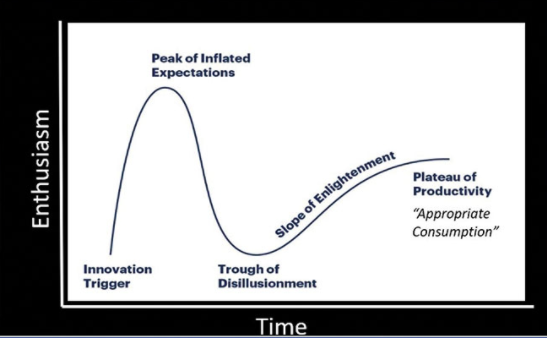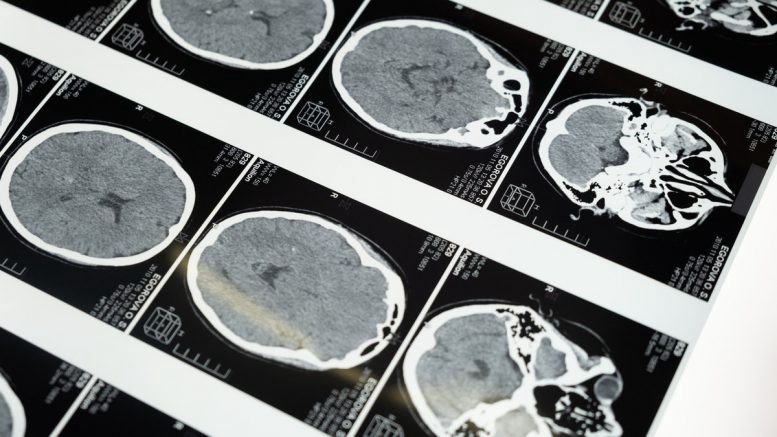the journal of mhealth
By Elad Walach, CEO of Aidoc
February 21, 2022.
Executive Summary
By Joaquim Cardoso MSc.
Chief Editor of The Health Strategy blog
February 21, 2022
What is the context?
- A few years ago … the discussion centered largely around whether AI would merely be a fad or if it might become a valuable tool for radiologists.
- Today, the tune has changed, but we’re far from the point of total industry enlightenment.
- After three years of hype, we’re now finding ourselves between two points of the cycle: the “trough of disillusionment”, and the “slope of enlightenment”
What are the predictions?
In this transitional period, we can expect to see three major transformations in the industry, which will be driven largely by a new hunger for enterprise AI amid labor shortages and growing patient volumes, some that are COVID-related, and others not:
- A top-down, executive-led approach to AI adoption
- Cross-disciplinary deployment. AI isn’t going to be a radiology solution or a neuroscience solution, but rather an enterprise-wide platform.
- Consolidation of the current innumerable stand-alone AI applications into mature operating systems.
- To be certain, after years of industry hype, 2022 is poised to be a year of consolidation and maturation in healthcare AI.
FULL VERSION

What to Expect from AI for Imaging in 2022
the journal of mhealth
By Elad Walach, CEO of Aidoc
February 21, 2022.
A few years ago, when AI first started to really become a hot topic of conversation in radiology, the discussion centered largely around whether AI would merely be a fad or if it might become a valuable tool for radiologists. Today, the tune has changed, but we’re far from the point of total industry enlightenment.
The hype is over, now’s the real race
To understand where we truly stand, we can frame the upcoming year (2022) in terms of the famous Gartner Hype Cycle . After three years of hype, we’re now finding ourselves between two points of the cycle: the “trough of disillusionment”-characterized by many vendors dropping out of the race and the consolidation of the market for only the players who can prove real value-and the “slope of enlightenment”-defined as the period of understanding and widespread adoption. We stand somewhere in between those two points of the Gartner cycle.

In this transitional period, we can expect to see three major transformations in the industry, which will be driven largely by a new hunger for enterprise AI amid labor shortages and growing patient volumes, some that are COVID-related, and others not:
- A top-down, executive-led approach to AI adoption
- Cross-disciplinary deployment. AI isn’t going to be a radiology solution or a neuroscience solution, but rather an enterprise-wide platform.
- Consolidation of the current innumerable stand-alone AI applications into mature operating systems.
Enterprise AI means top-down approach
Until recently, the process of adopting new AI technology in a healthcare institution has typically started with the clinical stakeholder asking a question in the form of “what if we could…..”? If and when this question finds a viable solution, the issue is then escalated to an administrative level for resource allocation, a process which is typically championed by some tech-avid clinician stakeholder(s). We have been fortunate to partner with several such “clinical champions,” whose lobbying efforts have been critical to AI adoption. This is, so to speak, grassroots AI.
But I predict this dynamic may soon change. Based on my conversations with senior managers and hospital executives, it seems hospital leadership are taking notice of the real impact of AI in various departments and are now wondering how they can leverage this technology for institutional-level benefits. This trend is beautifully illustrated in the case of pulmonary embolism response teams (PERT).
The PERT concept is a cross-disciplinary initiative to streamline the assessment, risk-stratification, and treatment of patients with PE. Several groups, such as Melamed et al , have published data that clearly indicate not only improved outcomes in the target population, but also positive effects on metrics significantly downstream, such as length of stay and ER throughput. In collaboration with several clinical partners, we have been developing an application to be used by all members of the PERT team to facilitate clinical decision-making and communication. What is particularly noteworthy is that our early successes have garnered the attention not only of the various clinical stakeholders, but by hospital administrators seeking to introduce this at their institutions, in a top-down fashion.
Our experience at Aidoc is not unique; a March 2021 of U.S. hospitals found that executive familiarity with AI had grown to 66 percent, up from an estimated 50 percent in 2019, a substantial increase. And with a firmer grasp on the clinical and economic benefits of AI, executives seem to be gearing up for more comprehensive AI adoption that would address wider institutional exigencies. For example, a December 2021 by Optum of U.S. healthcare executives showed that 98 percent of institutions had an AI strategy in place, with 48 percent having already implemented one. This new top-down approach to AI deployment will likely mean all hospital departments will be affected by AI integrations. Thus, grassroots AI is maturing into enterprise AI.
Silos down, efficiency up
This transition is of course occurring at a time of incredible challenge in the form of the COVID pandemic. Hospitals are seeking to mitigate unprecedented volume and acuity in the midst of a severe labor shortage and economic instability. Many hospital systems are looking to AI as a scalable way to improve efficiency and ensure quality across all departments. One way to achieve this is through AI-driven workflows; in which interdepartmental communication, point-of-care decision support, and coordinated use of resources are brought together to improve metrics across disparate departments. Strategically deployed AI can be a powerful tool in maximizing care coordination.
But in order to accomplish this, the traditional system of departmental “siloing”-in which resources and information are compartmentalized by service line or department-needs to give way to a more fluid, interconnected system. Rather than rely on manual processes to withdraw resources from multiple “silos,” in the near future care coordination could be orchestrated by AI-powered tools with real-time awareness of staff and other resources across the hospital. A handful of AI vendors have picked up on the rising demand for automation in this area, with several solutions on the market already utilized by hospitals in the U.S. But it won’t be easy to execute for the long haul and at scale without the underlying technical means-and that requires an AI platform.
Enlightenment of the AI operating system
Just as the advent of PACS in the radiology department decentralized access to imaging data, an AI platform integrated into the existing institutional IT system could have tremendous implications across the entire institution. But to date, such integration has proven elusive, as competing interests among all stakeholders have failed to produce the technical universality required. However, as more clinical leaders start employing AI solutions, and as the competitive advantage of well-tempered AI solutions become clearer, I predict the market demand from institutions will force a resolution to this problem. Hospital administrators will likely push the development of integrated, vendor-agnostic, cross-specialty AI platforms, delivering AI support across the institution, to replace the existing paradigm of single point AI solutions that target specific pathologies for certain specialties. And vendors will necessarily respond.
The results of all of this? The consolidation of AI consumption and, consequently, the AI market. What we are likely to see in 2022 is the rapid expansion of the larger AI vendors who proved their success earlier on when the hype first commenced, resulting in absorption of or partnership with the smaller, newer AI vendors. In an ecosystem populated by hundreds of vendors with innovative solutions for different pathologies, this could prove to be a huge boon to health systems, who will be able to engage with a single point of contact for all their needs-the platform vendor-while also getting the opportunity to create a bespoke system for their facility by selecting which AI solutions to integrate. This presupposes, however, a complete end-to-end solution with deeper integration. This is where we will see the rise of the AI operating system, a more robust technical infrastructure that can infuse power of AI across the enterprise.
To be certain, after years of industry hype, 2022 is poised to be a year of consolidation and maturation in healthcare AI.
By Elad Walach, CEO of Aidoc
Originally published at https://thejournalofmhealth.com on February 21, 2022.












